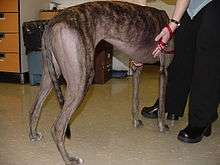Canine follicular dysplasia
Follicular dysplasia is a genetic disease of dogs causing alopecia, or hair loss. It is caused by hair follicles that are misfunctioning due to structural abnormality. There are several types, some affecting only certain breeds. Diagnosis is achieved through a biopsy, and treatment is rarely successful. Certain breeds, such as the Mexican Hairless Dog and Chinese Crested Dog, are bred specifically for alopecia.
Structural follicular dysplasia
Structural follicular dysplasia varies by breed but all involve weakened hairs that break easily. Hair loss is originally seen in areas of repeated grooming or trauma, for instance the neck because of contact with a collar. Hair regrowth may occur, but the hair will be even weaker and the pattern will repeat. The dogs are affected between the ages of two to four years, and it is most commonly seen on the back towards the tail. Progression of the hair loss to cover the trunk can occur.
Commonly affected breeds
Atrophic follicular dysplasia / Pattern baldness

In some breeds hair follicles in certain parts of the body become progressively miniaturized, analogous to what occurs in male pattern baldness in humans. It is most commonly seen in Dachshunds, Miniature Pinschers, and Chihuahuas.[2] Affected areas become progressively more alopecic. The pattern of hairlessness that results is somewhat breed-dependent and sex dependent. In short-coated toy and miniature dogs, ventral neck, ventral chest, ventral abdomen and inner thighs are affected. In males, the pinnae (ear flaps) are affected. In Greyhounds, the thighs are affected as well as the ventral chest and abdomen.
Cyclic follicular dysplasia
Cyclic follicular dysplasia is also known as seasonal alopecia.
It causes bilateral hair loss and hyperpigmentation of the flanks. The disease usually starts in the late fall or early spring, and can regrow in about six months, although the hair may be different in color or texture. Treatment with melatonin may result in hair regrowth sooner, so it is thought that the amount of daylight influences this condition. The dogs are affected between the ages of two to four years.[1]
Commonly affected breeds
- Silver Labrador
- Airedale Terrier
- Bulldog
- Staffordshire Bull Terrier
- Wirehaired Pointing Griffon
- Boxer
- Affenpinscher[1]
Boerboel ( South African Mastiff)
Follicular lipidosis
Follicular lipidosis is a type of follicular dysplasia found in the Rottweiler. It usually occurs before the age of nine months and involves loss of some of the mahogany or red hair of the face and feet. It is caused by lipid invasion of the hair follicle cells.
Color dilution alopecia

Color dilution alopecia is an inherited type of follicular dysplasia. It most commonly affects dogs with blue or fawn coats, which are dilutions of black and brown, respectively. Dilution is caused by irregularities in melanin transfer and storage. Melanosomes may clump within melanocytes of the skin and hair follicles, causing the hair shafts to easily fracture.[3] Signs of color dilution alopecia include hair loss and recurrent skin infection on the back. It can involve the whole body. The condition starts between the ages of six months and two years, depending on the degree of dilution.[4] Early hair loss occurs due to hair breakage, making it similar to structural follicular alopecia. It is important to treat the skin infections, and etretinate has been used to treat the hair loss.
Commonly affected breeds
- Dobermann - has the highest frequency of this condition. It occurs in 93 percent of blues and 75 percent of fawns.[1]
- Dachshund
- Great Dane
- Rhodesian Ridgeback
- Whippet
- Italian Greyhound
- Chow Chow
- Standard Poodle
- Miniature Pinscher
- Yorkshire Terrier
- Silky Terrier
- Chihuahua
- Boston Terrier
- Saluki
- Newfoundland
- German Shepherd Dog
- Shetland Sheepdog
- Schipperke
- Bernese Mountain Dog
- Bulldog
Other types of follicular dysplasia
The Siberian Husky and Alaskan Malamute have a type of follicular dysplasia that occurs between the ages of three and four months, possibly later in the Malamute. The guard hairs of the trunk are progressively lost and the coat turns reddish in color.
In black or red Dobermanns, Miniature Pinschers, and Manchester Terriers there is a type of follicular dysplasia that occurs between the ages of one and four years. It begins in the flank and spreads to the back.[1]
Black hair follicular dysplasia occurs in piebald dogs and causes hair loss in black-haired areas soon after birth. It is most commonly seen in Papillon (dog), Gordon setter, Saluki and Bearded Collie,[5] and is known to occur in Large Münsterländer dogs.[6] It is considered to be similar to color dilution alopecia and is inherited as an autosomal recessive trait.[7]
References
- 1 2 3 4 5 Griffin, Craig E.; Miller, William H.; Scott, Danny W. (2001). Small Animal Dermatology (6th ed.). W.B. Saunders Company. ISBN 0-7216-7618-9.
- ↑ Carlotti, Didier-Noël (2005). "Non-Hormonal Alopecia". Proceedings of the 30th World Congress of the World Small Animal Veterinary Association. Retrieved 2007-03-04.
- ↑ Philipp U, Hamann H, Mecklenburg L, Nishino S, Mignot E, Günzel-Apel A, Schmutz S, Leeb T (2005). "Polymorphisms within the canine MLPH gene are associated with dilute coat color in dogs". BMC Genet. 6: 34. PMC 1183202
 . PMID 15960853. doi:10.1186/1471-2156-6-34.
. PMID 15960853. doi:10.1186/1471-2156-6-34. - ↑ Iwasaki, Toshiroh (2004). "Non-Inflammatory Alopecia". Proceedings of the 29th World Congress of the World Small Animal Veterinary Association. Retrieved 2007-03-04.
- ↑ "Hereditary Alopecia and Hypotrichosis". The Merck Veterinary Manual. 2006. Retrieved 2007-03-04.
- ↑ von Bomhard W, Mauldin E, Schmutz S, Leeb T, Casal M (2006). "Black hair follicular dysplasia in Large Münsterländer dogs: clinical, histological and ultrastructural features". Vet Dermatol. 17 (3): 182–8. PMC 3330242
 . PMID 16674733. doi:10.1111/j.1365-3164.2006.00517.x.
. PMID 16674733. doi:10.1111/j.1365-3164.2006.00517.x. - ↑ Schmutz S, Moker J, Clark E, Shewfelt R (1998). "Black hair follicular dysplasia, an autosomal recessive condition in dogs". Can Vet J. 39 (10): 644–6. PMC 1539457
 . PMID 9789677.
. PMID 9789677.